Design and Material Optimization of Oil Plant Piping Structure for Mitigating Erosion Wear
Abstract
Featured Application
Abstract
1. Introduction
2. CFD Modeling
2.1. Modeling of Flow
2.2. Turbulence Model
2.3. Discrete Phase Model
2.4. Erosion Rate
3. Piping Structure Design and Case Formation
3.1. Piping Material
3.2. Piping Thickness
3.3. Elbow Angle
3.4. Fluid Velocity
3.5. Summary of Simulation Cases
4. CFD Analysis
4.1. Geometry Modeling and Mesh Generation
4.2. Grid Independency Analysis
4.3. Material Properties
4.4. Boundary Conditions
4.5. Injection of Solid Particles Using DPM
4.6. CFD Analysis Setup
5. Results and Discussions
5.1. Effect of Pipe Material on TDR and ER
5.2. Effect of Pipe Thickness on TDR and ER
5.3. Effect of Elbow Angle on TDR and ER
5.4. Effect of Velocity on TDR and ER
5.5. Optimize Model
6. Conclusions
- Upon comparing the simulation results of pipe material cases A90, and I90 with C90, it is evident from the CFD results that I90, in which the Inconel 617 alloy material was utilized, exhibited a significantly lower TDR and ER than A90 and C90. This decrease of the TDR and ER in I90 is attributed to the distinctive material properties of I90. Notably, I90 showcased a higher density and a superior Brinell hardness number in comparison to the properties of A90 and C90. Additionally, I90 exhibited lower thermal conductivity. These specific material characteristics played a crucial role in significantly reducing the erosion rate within the piping structure. Consequently, I90 emerged as a resilient choice, offering notable resistance against erosion.
- After a thorough comparison of pipe thickness cases, specifically C90-tn and C90-tk, with the C90, the results revealed significant distinctions. C90-tk, characterized by a substantial pipe thickness (t/D) of 14.02/87.02 mm, demonstrated superior resilience against the impact of solid particles, owing to the provision of a more substantial material barrier against erosion. Notably, it exhibited the lowest TDR and ER in contrast to C90-tn and C90, in which thin pipe walls were used. This highlights the effectiveness of a thicker wall in mitigating erosion-related damage, resulting in decreased TDRs and ERs.
- When comparing the outcomes of elbow angle cases C45 and C25, with the C90, it was observed that C25, featuring a 25-degree elbow angle, exhibited the lowest TDR and ER compared to C45 and C90, with and elbow angles. This attributes to the fact that a elbow induces a less abrupt change in direction, reducing turbulence and fluid velocity gradients, ultimately leading to a decrease in the ER. The smoother flow transition in the elbow, as opposed to sharper angles like and , minimizes flow separation thereby mitigates erosion. The favorable flow conditions resulting from this smoother transition contribute to the observed reduction in TDR and ER in C25.
- Upon comparing the CFD results of fluid velocity cases C90-lv and C90-hv, with C90, C90-lv, with a velocity of 0.344 m/s, demonstrated the least TDR and ER compared to the C90, in which a fluid velocity of 0.688 m/s was used. The reduction in velocity in C90-lv diminished the impingement force of solid particles on the piping surface, thereby decreasing their kinetic energy and erosive potential. This deceleration in fluid flow results in a reduction in erosion action, ultimately lowering the turbulence and erosive forces exerted on the walls of piping structure.
- The outcomes of the CFD analysis in this investigation suggested optimal configurations for pipe material, pipe thickness, elbow angle, and fluid velocity. Employing these refined parameters, an optimized piping structure (OP) was designed, and the comparison with the standard piping structure (C90) showcased a notable 80% decrease in TDR and a remarkable 99.2% decrease in ER. This reaffirms the effectiveness of utilizing Inconel 617 alloy, adopting a higher pipeline thickness, opting for a elbow angle, and employing a lower fluid velocity for enhancing piping structure durability and effectively mitigating erosion.
- Crude oil is critical, accounting for 34% of the global energy system and over 90% of world transportation. Given the global increase in oil demand since 2004, research and development on non-conventional oil plants are essential. This study highlights the crucial role of pipelines in non-conventional oil plants and confirms the importance of addressing pipeline erosion. Our work emphasizes the necessity for continued research in the piping optimization area. In future studies, we aim to conduct in-depth fatigue and buckling analyses to enhance safety, extend pipeline life, and improve reliability. Additionally, we plan to validate our numerical results with experiments on actual pipelines, thereby proving the reliability of our findings.
Author Contributions
Funding
Data Availability Statement
Conflicts of Interest
References
- Berkowitz, N.; Speight, J.G. The Oil Sands of Alberta. Fuel 1975, 54, 138–149. [Google Scholar] [CrossRef]
- Bedore, J.; Turner, L. The Industrialization of the Middle Eastern Oil Producers. World Today 1977, 33, 326–334. [Google Scholar]
- Dorian, J.P. Central Asia: A Major Emerging Energy Player in the 21st Century. Energy Policy 2006, 34, 544–555. [Google Scholar] [CrossRef]
- Study of Greenhouse Gases Reduction Alternatives for the Exploitation of Non-Conventional Oil Sands in Canada (Conference) | ETDEWEB. Available online: https://www.osti.gov/etdeweb/biblio/21219437 (accessed on 24 November 2023).
- Alberta Oil Sands Development|PNAS. Available online: https://www.pnas.org/doi/abs/10.1073/pnas.0912880107 (accessed on 24 November 2023).
- Hedrick, B.; Seibert, K.; Crewe, C. A New Approach to Heavy Oil and Bitumen Upgrading. Available online: https://es.scribd.com/document/638939122/A-New-Approach-to-Heavy-Oil-and-Bitumen-Upgrading (accessed on 17 April 2023).
- Thermal Techniques for the Recovery of Heavy Oil and Bitumen|SPE International Improved Oil Recovery Conference in Asia Pacific|OnePetro. Available online: https://onepetro.org/SPEAPIOR/proceedings-abstract/05IIOR/All-05IIOR/89539 (accessed on 24 November 2023).
- Okonkwo, P.C.; Mohamed, A.M. Erosion-Corrosion in Oil and Gas Industry: A Review. Int. J. Metall. Mater. Sci. Eng. 2014, 4, 7–28. [Google Scholar]
- Wee, S.K.; Yap, Y.J. CFD Study of Sand Erosion in Pipeline. J. Pet. Sci. Eng. 2019, 176, 269–278. [Google Scholar] [CrossRef]
- Alghurabi, A.; Mohyaldinn, M.; Jufar, S.; Younis, O.; Abduljabbar, A.; Azuwan, M. CFD Numerical Simulation of Standalone Sand Screen Erosion Due to Gas-Sand Flow. J. Nat. Gas Sci. Eng. 2021, 85, 103706. [Google Scholar] [CrossRef]
- Peng, W.; Cao, X. Numerical Prediction of Erosion Distributions and Solid Particle Trajectories in Elbows for Gas–Solid Flow. J. Nat. Gas Sci. Eng. 2016, 30, 455–470. [Google Scholar] [CrossRef]
- Arabnejad, H.; Mansouri, A.; Shirazi, S.A.; McLaury, B.S. Abrasion Erosion Modeling in Particulate Flow. Wear 2017, 376, 1194–1199. [Google Scholar] [CrossRef]
- McLaury, B.S.; Wang, J.; Shirazi, S.A.; Shadley, J.R.; Rybicki, E.F. Solid Particle Erosion in Long Radius Elbows and Straight Pipes. In Proceedings of the SPE Annual Technical Conference and Exhibition, San Antonio, TX, USA, 5–8 October 1997; OnePetro: Richardson, TX, USA, 1997. [Google Scholar]
- Parsi, M.; Najmi, K.; Najafifard, F.; Hassani, S.; McLaury, B.S.; Shirazi, S.A. A Comprehensive Review of Solid Particle Erosion Modeling for Oil and Gas Wells and Pipelines Applications. J. Nat. Gas Sci. Eng. 2014, 21, 850–873. [Google Scholar] [CrossRef]
- Oka, Y.I.; Ohnogi, H.; Hosokawa, T.; Matsumura, M. The Impact Angle Dependence of Erosion Damage Caused by Solid Particle Impact. Wear 1997, 203, 573–579. [Google Scholar] [CrossRef]
- Parent, L.L.; Li, D.Y. Wear of Hydrotransport Lines in Athabasca Oil Sands. Wear 2013, 301, 477–482. [Google Scholar] [CrossRef]
- Peng, G.; Huang, X.; Zhou, L.; Zhou, G.; Zhou, H. Solid-Liquid Two-Phase Flow and Wear Analysis in a Large-Scale Centrifugal Slurry Pump. Eng. Fail. Anal. 2020, 114, 104602. [Google Scholar] [CrossRef]
- Beccati, N.; Ferrari, C.; Parma, M.; Semprini, M. Eulerian Multi-Phase CFD Model for Predicting the Performance of a Centrifugal Dredge Pump. Int. J. CMEM 2019, 7, 316–326. [Google Scholar] [CrossRef][Green Version]
- Sharma, M.; Goyal, D.K.; Kaushal, G.; Grover, N.K.; Bansal, A.; Goyal, K. CFD and Experimental Study of Slurry Erosion Wear in Hydro-Machinery. Mater. Today Proc. 2022, 62, 7581–7594. [Google Scholar] [CrossRef]
- Ariyaratne, W.K.H.; Ratnayake, C.; Melaaen, M.C. CFD Modeling of Dilute Phase Pneumatic Conveying in a Horizontal Pipe Using Euler–Euler Approach. Part. Sci. Technol. 2019, 37, 1015–1023. [Google Scholar] [CrossRef]
- Martins, N.M.; Carrico, N.J.; Ramos, H.M.; Covas, D.I. Velocity-Distribution in Pressurized Pipe Flow Using CFD: Accuracy and Mesh Analysis. Comput. Fluids 2014, 105, 218–230. [Google Scholar] [CrossRef]
- Ansys Workbench 2022. Available online: https://www.ansys.com/products/ansys-workbench (accessed on 24 November 2023).
- Sultan, R.A.; Rahman, M.A.; Rushd, S.; Zendehboudi, S.; Kelessidis, V.C. Validation of CFD Model of Multiphase Flow through Pipeline and Annular Geometries. Part. Sci. Technol. 2019, 37, 685–697. [Google Scholar] [CrossRef]
- Na, S.J.; Kim, Y.S.; Jeon, E.S. Analysis of Erosion Minimization for a Slurry Pump Using Discrete Phase Model Simulations. Appl. Sci. 2022, 12, 1597. [Google Scholar] [CrossRef]
- Abdulla, A. Estimating Erosion in Oil and Gas Pipe Line Due to Sand Presence 2011. Available online: https://www.diva-portal.org/smash/get/diva2:833640/FULLTEXT01.pdf (accessed on 24 November 2023).
- Eulerian-Eulerian Simulation of Particle-Liquid Slurry Flow in Horizontal Pipe. Available online: https://www.hindawi.com/journals/jpe/2016/5743471/ (accessed on 30 May 2024).
- Hong, B.; Li, Y.; Li, X.; Ji, S.; Yu, Y.; Fan, D.; Qian, Y.; Guo, J.; Gong, J. Numerical Simulation of Gas-Solid Two-Phase Erosionf or Elbow and Tee Pipe in Gas Field. Energies 2021, 14, 6609. [Google Scholar] [CrossRef]
- Singh, J.; Gill, H.S.; Vasudev, H. Computational Fluid Dynamics Analysis on Role of Particulate Shape and Size in Erosion of Pipe Bends. Int. J. Interact. Des. Manuf. 2023, 17, 2631–2646. [Google Scholar] [CrossRef]
- Pereira, F.A.R.; Ataíde, C.H.; Barrozo, M.A.S. CFD Approach Using a Discrete Phase Model for Annular Flow Analysis. Lat. Am. Appl. Res. 2010, 40, 53–60. [Google Scholar]
- Sekavčnik, M.; Ogorevc, T.; Škerget, L. CFD Analysis of the Dynamic Behaviour of a Pipe System. Forsch Ingenieurwes 2006, 70, 139–144. [Google Scholar] [CrossRef]
- Marrah, A. Simulating of Erosion Modeling Using ANSYS Fluid Dynamics. Ph.D. Thesis, Memorial University of Newfoundland, St. John’s, NL, Canada, 2019. [Google Scholar]
- Lv, Z.; Hou, R.; Tian, Y.; Huang, C.; Zhu, H. Investigation on Flow Field of Ultrasonic-Assisted Abrasive Waterjet Using CFD with Discrete Phase Model. Int. J. Adv. Manuf. Technol. 2018, 96, 963–972. [Google Scholar] [CrossRef]
- Zhao, Y.; Ma, H.; Xu, L.; Zheng, J. An Erosion Model for the Discrete Element Method. Particuology 2017, 34, 81–88. [Google Scholar] [CrossRef]
- Habib, M.A.; Ben-Mansour, R.; Badr, H.M.; Kabir, M.E. Erosion and Penetration Rates of a Pipe Protruded in a Sudden Contraction. Comput. Fluids 2008, 37, 146–160. [Google Scholar] [CrossRef]
- Khan, R.; Ya, H.; Pao, W. An Experimental Study on the Erosion-Corrosion Performance of AISI 1018 Carbon Steel and AISI 304L Stainless Steel 90-Degree Elbow Pipe. Metals 2019, 9, 1260. [Google Scholar] [CrossRef]
- Rajkumar, Y.; Shirazi, S.A.; Karimi, S. Effect of Pipe Size on Erosion Measurements and Predictions in Liquid-Dominated Multiphase Flows for the Elbows. Wear 2023, 523, 204797. [Google Scholar] [CrossRef]
- Near-Wall k-Epsilon Turbulence Modeling|AIAA Journal. Available online: https://arc.aiaa.org/doi/abs/10.2514/3.10222?journalCode=aiaaj (accessed on 24 November 2023).
- ASME B36.10M-2015; Welded and Seamless Wrought Steel Pipe. The American Society of Mechanical Engineers (ASME): New York, NY, USA, 2015.
- An Investigation of Erosion Prediction for 15° to 90° Elbows by Numerical Simulation of Gas-Solid Flow—ScienceDirect. Available online: https://www.sciencedirect.com/science/article/pii/S003259101830305X (accessed on 24 November 2023).
- Mazumder, Q.H.; Zhao, S.; Ahmed, K. Effect of Bend Radius on Magnitude and Location of Erosion in S-Bend. Model. Simul. Eng. 2015, 2015, 930497. [Google Scholar] [CrossRef][Green Version]
- Li, C.; Huang, Q.; Yan, S.; Huang, T. Parametric CFD Studies on Erosion in 3D Double Elbow. Int. J. Eng. Syst. Model. Simul. 2016, 8, 264. [Google Scholar] [CrossRef]
- Lopez, D.; Congote, J.P.; Cano, J.R.; Toro, A.; Tschiptschin, A.P. Effect of Particle Velocity and Impact Angle on the Corrosion–Erosion of AISI 304 and AISI 420 Stainless Steels. Wear 2005, 259, 118–124. [Google Scholar] [CrossRef]
- Islam, M.A.; Farhat, Z.N. Effect of Impact Angle and Velocity on Erosion of API X42 Pipeline Steel under High Abrasive Feed Rate. Wear 2014, 311, 180–190. [Google Scholar] [CrossRef]




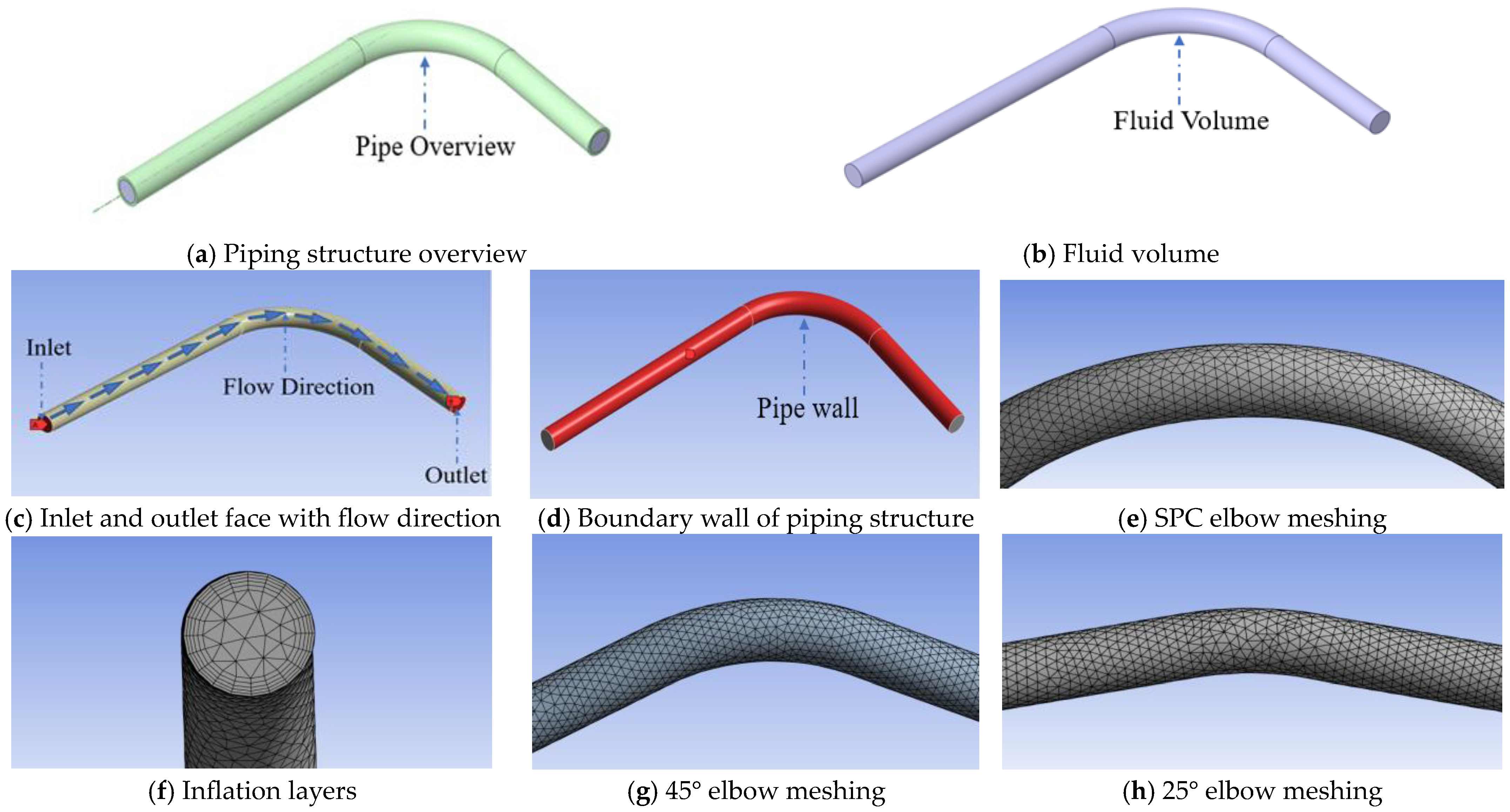

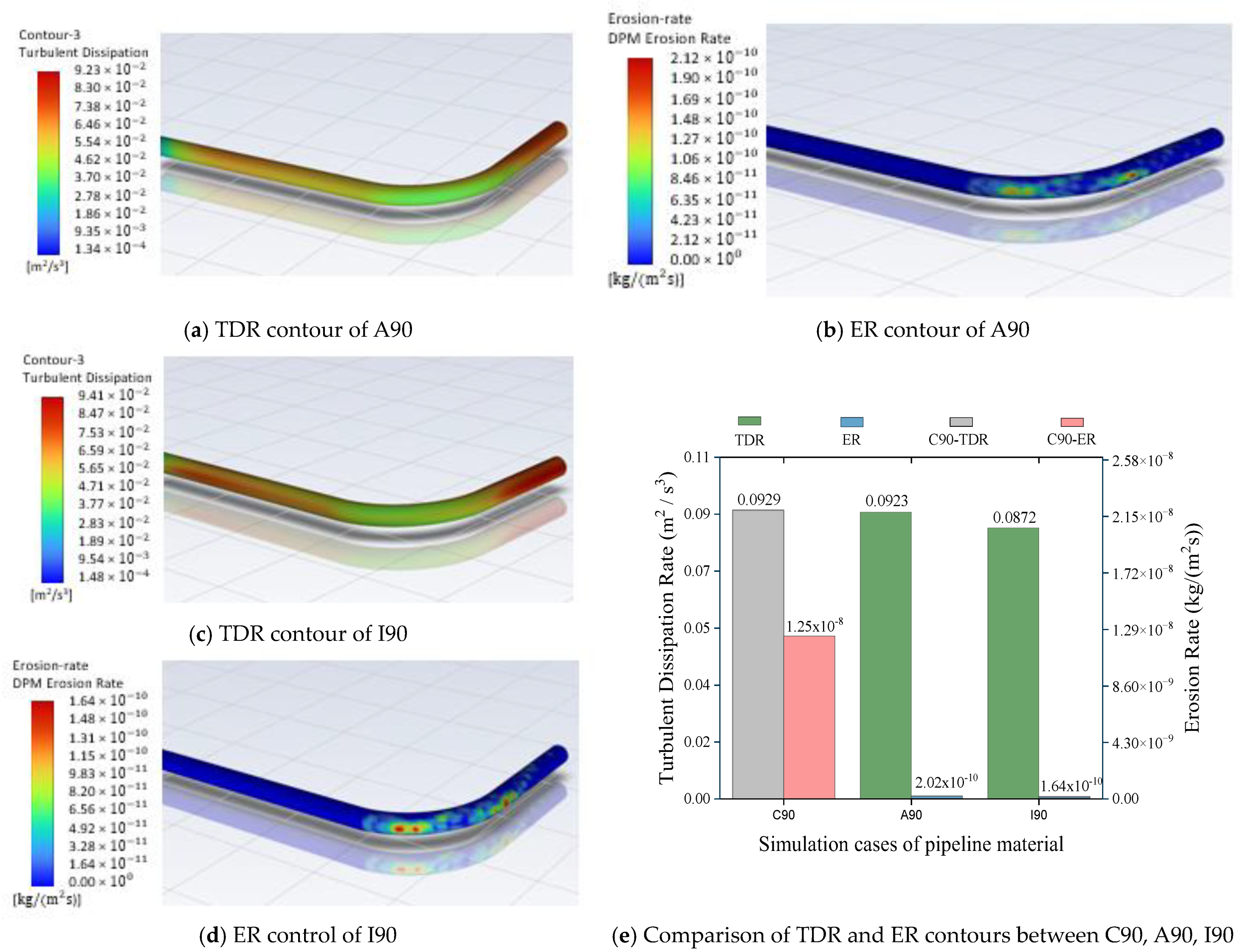


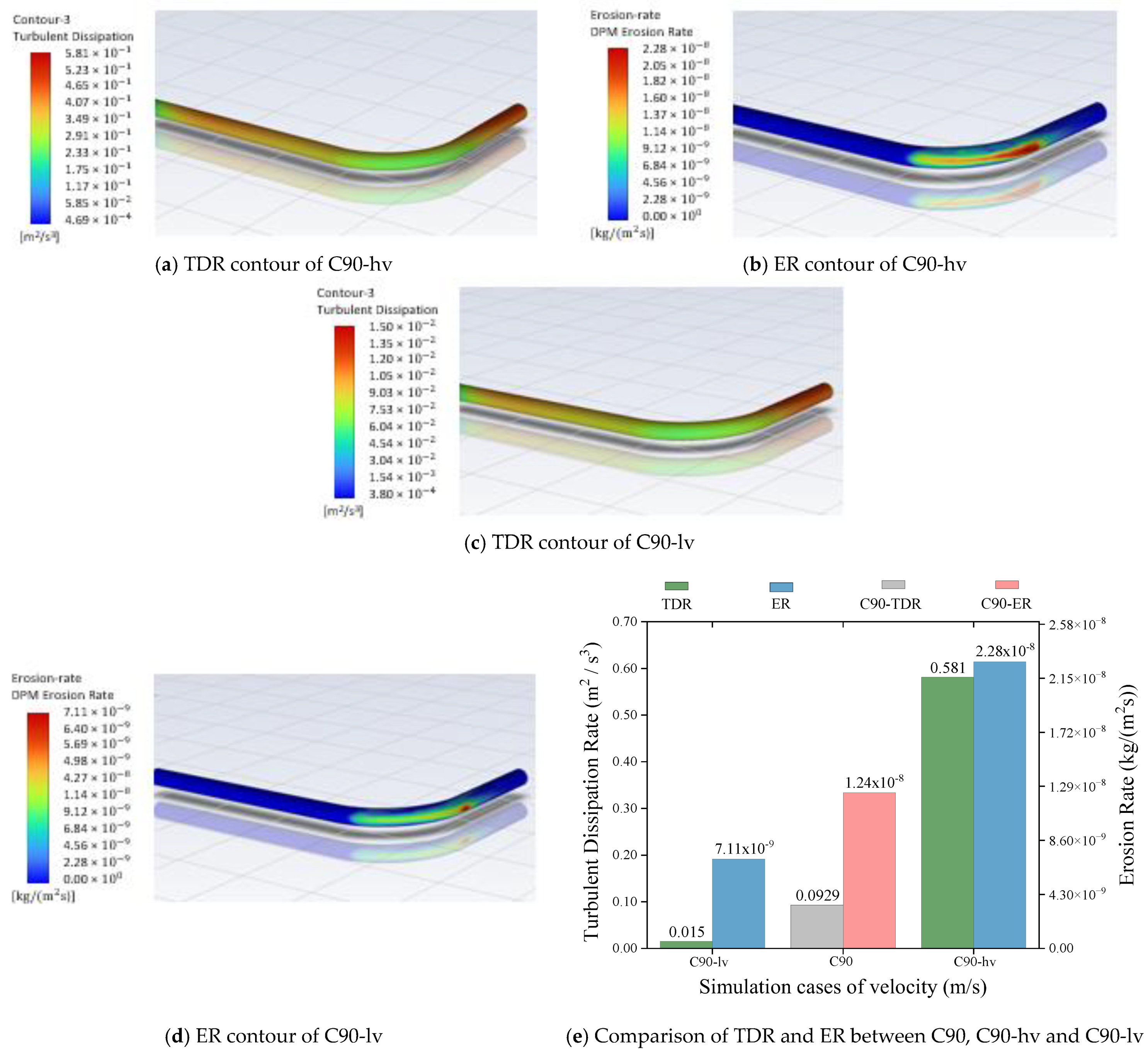
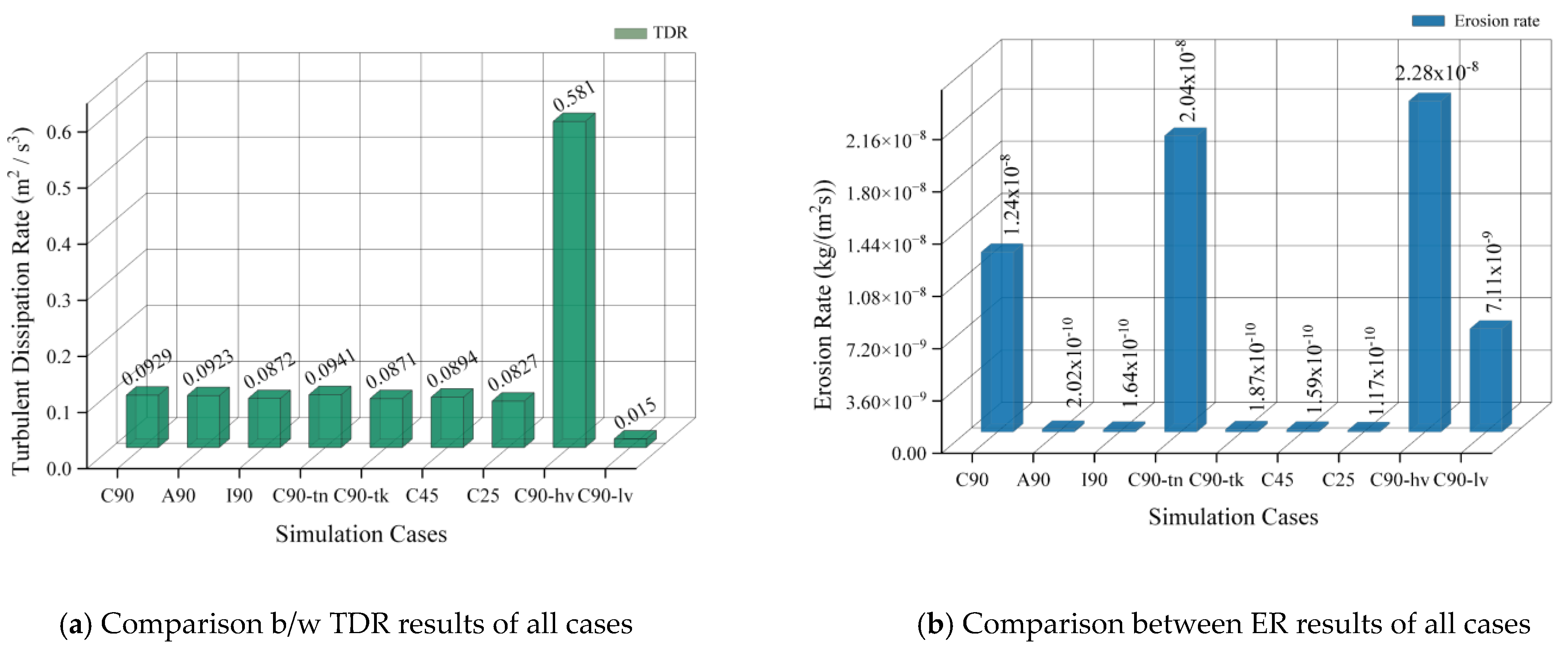


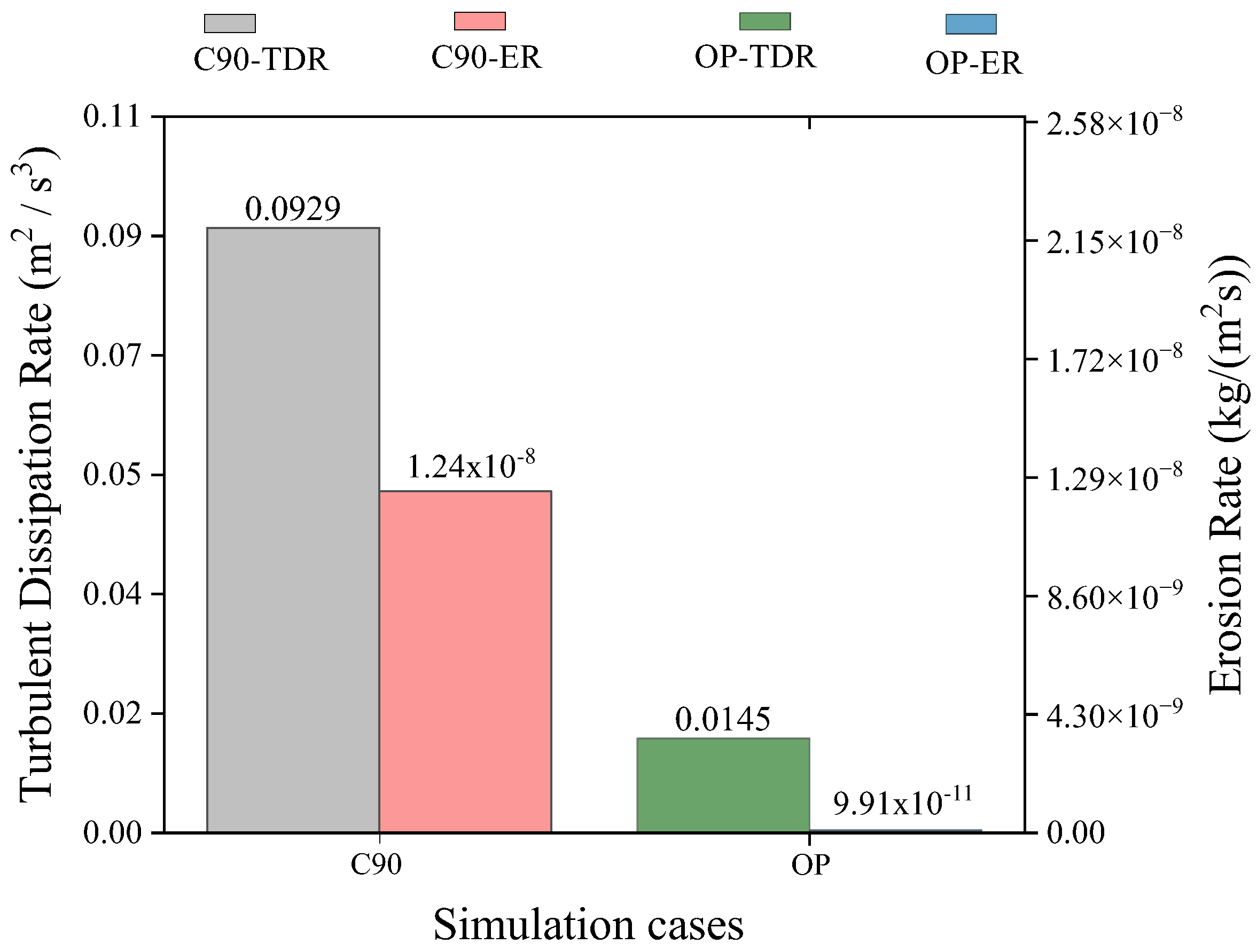
| Pipeline Material | Carbon Steel | AISI 304 Stainless Steel | Inconel 617 Alloy |
|---|---|---|---|
| Density (g/) | 7.85 | 8.00 | 8.36 |
| Brinell Hardness Number | 120 | 123 | 170 |
| Specific Heat J/(kg·k) | 480 | 500 | 419 |
| Thermal Conductivity(w/m-k) | 47.6 | 16.2 | 13.6 |
| Modulus of Elasticity (Gpa) | 200 | 193 | 173 |
| Poison’s Ratio (v) | 0.29 | 0.29 | 0.30 |
| Case ID | Variables | Pipe Material | Pipe Outer Diameter (D) (mm) | Pipe Inner Diameter (mm) | Pipe Wall Thickness (t) (mm) | Elbow Angle (Degree) | Velocity (m/s) |
|---|---|---|---|---|---|---|---|
| C90 | Standard pipe | Carbon Steel SCH80 | 73 | 58.98 | 7.01 | 90 | 0.688 |
| A90 | Pipe material | AISI 304 Stainless Steel | 73 | 58.98 | 7.01 | 90 | 0.688 |
| I90 | Inconel 617 Alloy | 73 | 58.98 | 7.01 | 90 | 0.688 | |
| C90-tn | Pipe size (t/D) | Carbon Steel | 69.3 | 58.98 | 5.16 | 90 | 0.688 |
| C90-tk | Carbon Steel | 87.02 | 58.98 | 14.02 | 90 | 0.688 | |
| C45 | Elbow angle | Carbon Steel | 73 | 58.98 | 7.01 | 45 | 0.688 |
| C25 | Carbon Steel | 73 | 58.98 | 7.01 | 25 | 0.688 | |
| C90-hv | Velocity | Carbon Steel | 73 | 58.98 | 7.01 | 90 | 1.38 |
| C90-lv | Carbon Steel | 73 | 58.98 | 7.01 | 90 | 0.344 |
| Element size | 61.431 |
| Growth rate | 1.2 |
| Sizing | |
| Growth rate | 1.2 |
| Max size | 122.86 mm |
| Mesh Defeaturing | |
| Defeature size | 0.30715 |
| Capture Curvature | yes |
| Curvature in size | 0.61431 mm |
| Curvature normal Angle | 18.0 degree |
| Capture Proximity | No |
| Bounding box diagonal | 1228.6 mm |
| Average surface area | 57,194 mm2 |
| Minimum edge length | 92.653 mm |
| Inflation Option | Smooth Transition |
|---|---|
| Transition ratio | 0.272 |
| Maximum layers | 5 |
| Growth rate | 1.2 |
| Inflation algorithm | Pre |
| P1—Mesh Element Size [mm] | P2—Mesh Nodes | P3—Mesh Elements | P4—Turbulent Dissipation Rate [m2/s3] | P5—Erosion Rate (kg/(m−2 s) | |
|---|---|---|---|---|---|
| Name | P1 | P2 | P3 | P5 | P4 |
| DP 0 | 61.431 | 14,469 | 12,956 | 9.29 × 10−2 | 1.24 × 10−8 |
| DP 1 | 50 | 14,628 | 13,114 | 9.29 × 10−2 | 1.24 × 10−8 |
| DP 2 | 40 | 17,368 | 15,770 | 9.29 × 10−2 | 1.24 × 10−8 |
| Fluid Type | Oily Water (99.97%) | Bitumen (0.02%) | CO2 (0.01%) |
|---|---|---|---|
| Density (g/) | 9.561 | 10.15 | 1.7878 × |
| Specific Heat J/(kg·k) | 4186.8 | 1850 | 840.37 |
| Thermal Conductivity (w/m-k) | 0.6 | 160 | 0.0145 |
| Viscosity (kg/m s) | 0.001003 | 240 | 1.37 × 10−5 |
| Fluid Temperature (°C) | 90 | 90 | 90 |
| Velocity and Inert Particles Properties | Case 1–7 | Case-8 | Case-9 |
|---|---|---|---|
| Fluid Velocity (m/s) | 0.688 | 1.38 | 0.344 |
| Fluid Temperature | 90 | 90 | 90 |
| Environment Temperature | −10 | −10 | −10 |
| Bitumen and CO2 Velocity (m/s) | 0.688 | 1.38 | 0.344 |
| Gauge Pressure (kg f/) | 5000 | 10,000 | 2500 |
| Flow rate of water (/h) | 6.77 | 13.57 | 3.38 |
| Mass Flow rate of water (99.97%) (kg/s) | 1.79 | 3.6 | 0.898 |
| Bitumen Particle Size (mm) | 2.5 × | 2.5 × | 2.5 × |
| Mass Flow rate of Bitumen (0.02%) (kg/s) | 3.58 × | 7.2 × | 1.796 × |
| CO2 Particle Size (mm) | 3.3 × | 3.3 × | 3.3 × |
| Mass Flow rate of CO2 (0.01%) (kg/s) | 1.79 × | 3.6 × | 8.98 × |
Disclaimer/Publisher’s Note: The statements, opinions and data contained in all publications are solely those of the individual author(s) and contributor(s) and not of MDPI and/or the editor(s). MDPI and/or the editor(s) disclaim responsibility for any injury to people or property resulting from any ideas, methods, instructions or products referred to in the content. |
© 2024 by the authors. Licensee MDPI, Basel, Switzerland. This article is an open access article distributed under the terms and conditions of the Creative Commons Attribution (CC BY) license (https://creativecommons.org/licenses/by/4.0/).
Share and Cite
Ahn, J.-H.; Asif, R.; Lee, H.-W.; Hwang, I.-J.; Hu, J.-W. Design and Material Optimization of Oil Plant Piping Structure for Mitigating Erosion Wear. Appl. Sci. 2024, 14, 5234. https://doi.org/10.3390/app14125234
Ahn J-H, Asif R, Lee H-W, Hwang I-J, Hu J-W. Design and Material Optimization of Oil Plant Piping Structure for Mitigating Erosion Wear. Applied Sciences. 2024; 14(12):5234. https://doi.org/10.3390/app14125234
Chicago/Turabian StyleAhn, Jun-Hyuk, Rabea Asif, Heon-Woo Lee, In-Ju Hwang, and Jong-Wan Hu. 2024. "Design and Material Optimization of Oil Plant Piping Structure for Mitigating Erosion Wear" Applied Sciences 14, no. 12: 5234. https://doi.org/10.3390/app14125234
APA StyleAhn, J.-H., Asif, R., Lee, H.-W., Hwang, I.-J., & Hu, J.-W. (2024). Design and Material Optimization of Oil Plant Piping Structure for Mitigating Erosion Wear. Applied Sciences, 14(12), 5234. https://doi.org/10.3390/app14125234







